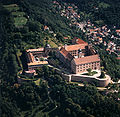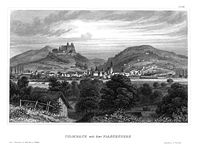
Plassenburg
Encyclopedia


Castle
A castle is a type of fortified structure built in Europe and the Middle East during the Middle Ages by European nobility. Scholars debate the scope of the word castle, but usually consider it to be the private fortified residence of a lord or noble...
in the city of Kulmbach
Kulmbach
Kulmbach is the capital of the district of Kulmbach in Bavaria in Germany. The town is famous for Plassenburg Castle, which houses the largest tin soldier museum in the world, and for its famous sausages, or Bratwürste.-Location:...
in Bavaria
Bavaria
Bavaria, formally the Free State of Bavaria is a state of Germany, located in the southeast of Germany. With an area of , it is the largest state by area, forming almost 20% of the total land area of Germany...
. It is one of the most impressive castles in Germany and a symbol of the city. It was first mentioned in 1135. The Plassenberg family were ministerial
Ministerialis
Ministerialis ; a post-classical Latin word, used in English, meaning originally servitor, agent, in a broad range of senses...
of the counts of Andechs (later the dukes of Andechs-Meranien) and used as their seat the Plassenburg. The House of Guttenberg
House of Guttenberg
The House of Guttenberg is a prominent Franconian family which traces its origins back to 1149 with a Gundeloh v. Blassenberg . Though, the first mention in a document is dated 1158. The name Guttenberg is derived from Guttenberg and was adopted by a Heinrich von Blassenberg around 1310...
, a prominent Franconian noble family, traces its origins back to 1149 with a Gundeloh v. Blassenberg (Plassenberg). The name Guttenberg is derived from Guttenberg
Guttenberg, Bavaria
Guttenberg is a municipality in the district of Kulmbach in Bavaria in Germany. The town is closely tied to the aristocratic family by the same name, the House of Guttenberg, which owns most of the land in the area...
and was adopted by a Heinrich von Blassenberg around 1310. From 1340, the Hohenzollerns governed from Plassenburg castle their territories in Franconia
Franconia
Franconia is a region of Germany comprising the northern parts of the modern state of Bavaria, a small part of southern Thuringia, and a region in northeastern Baden-Württemberg called Tauberfranken...
till 1604. The Plassenburg was fortress and residence for the Hohenzollerns.
It was destroyed in 1554 at the end of the second Margravian war (1552–1554) of margrave Albert Alcibiades. The Plassenburg was later rebuilt by the architect Caspar Vischer as an impressive stronghold and as a huge palace. In 1792, Margrave Alexander sold the Plassenburg to his cousin, the King of Prussia. A combined Bavarian and French army under the command of Jérôme Bonaparte, brother of Napoleon, besieged the Plassenburg in 1806. In 1810, Kulmbach
Kulmbach (district)
Kulmbach is a district in Bavaria, Germany. It is bounded by the districts of Kronach, Hof, Bayreuth and Lichtenfels.-History:...
became Bavarian and the castle was used as a prison and as a military hospital. During the second world war, the Organisation Todt used the Plassenburg as a training camp and recreation home. Today, it is a museum and a venue for cultural events.
It contains a significant collection of Prussian military artifacts and portraits.
History
The Plassenburg was first mentioned in 1135, when it was described by Count Berthold II of Andechs as comes de Plassenberch. Presumably he was also the founder of the castle, which was built to the west of an earlier fortified farmstead. To begin with, the castle was a central supporting stronghold for the Meranian rulers of the Upper Main and Franconian Forest.After the death of the last Andechs-Meranian, Duke Otto VIII, his brother-in-law divided his inheritance. The Plassenburg with Kulmbach, Berneck, Goldkronach
Goldkronach
Goldkronach is a town in the district of Bayreuth, in Bavaria, Germany. It is situated near the Fichtelgebirge, 12 km northeast of Bayreuth.-History:On 25 June 1836, at 22:15, residents awoke to a man yelling "Fire! Fire!"...
, Wirsberg
Wirsberg
Wirsberg is a municipality in the district of Kulmbach in Bavaria in Germany.-City arrangement:Wirsberg is arranged in the following boroughs:* Birkenhof* Cottenau* Einöde* Goldene Adlerhütte* Neufang* Osserich* Schlackenmühle* Sessenreuth...
, Trebgast
Trebgast
Trebgast is a municipality in the district of Kulmbach in Bavaria in Germany.-City arrangement:Trebgast is arranged in the following boroughs:* Feuln* Lindau* Trebgast* Waizendorf...
and Pretzendorf (now Himmelkron
Himmelkron
Himmelkron is a municipality in the district of Kulmbach in Bavaria in Germany.-City arrangement:Himmelkron is arranged in the following boroughs:* Gössenreuth* Himmelkron* Lanzendorf...
) went to Hermann III and Otto III, Count of Orlamünde. The two sons of Herman II (died 1247) and Beatrix of Andechs-Merania initially ruled together as lords of Plassenburg castle. After 1278 they divided the inheritance of their father, whereupon Otto III was given sole possession of the domain of Plassenburg and the territory around Weimar. Otto III died in 1285 and the Plassenburg appeared soon afterwards in the hands of his son Otto IV. His son in turn, Count Otto VI of Orlamünde, who was the only Orlamünde since 1323 who was described as "Lord of Plassenburg", pledged this lordship together with the Plassenburg, Kulmbach, Trebgast and Berneck in 1338 to Burgrave John II of Nuremberg. As a result, after Otto VI's death in 1340, Plassenburg fell to the burgraves of Nuremberg from the House of Hohenzollern.
Gradually, the Plassenburg developed into a new centre of power for the Hohenzollerns. At the time of Burgrave Frederick V of Nuremberg (who reigned 1357–1397), the Plassenburg had already outstripped the Cadolzburg
Cadolzburg
Cadolzburg is a municipality in the district of Fürth, in Bavaria, Germany. It is situated 11 km west of Fürth.In the year 2007 Cadolzburg celebrated its 850th anniversary.- Notable persons :* Albert III, Elector of Brandenburg...
- a traditional burgravial residence. In 1397 Burgrave Frederick V stepped down from the business of government and chose the Plassenburg as his retirement home. The Hohenzollerns' territory in Franconia was divided between his sons, John III and Frederick VI, later to be the Elector of Brandenburg, in accordance with the Dispositio Fridericiana of 1385. Thus the Plassenburg became the centre of power for the so-called Principality of the Mountains (Fürstentum ob dem Gebirg), later the Margraviate of Brandenburg-Kulmbach. After the death of John III in 1420, his estate fell to his brother, Frederick, who, in 1421, created the office of "Captain of the Mountains" to rule his domain. Plassenburg remained the administrative centre of this hilly principality until after the middle of the 16th century.
The internment of the Countess Barbara of Brandenburg in March 1493, began the sad chapter of Plassenburg as a family prison. This reach a peak in February 1515 when Margrave Casimir of Brandenburg locked up his father, Margrave Frederick the Elder of Brandenburg, in a tower room at Plassenburg which he could not leave for 12 years. In 1542 Margrave Albrecht Alcibiades moved the Residenz
Residenz
Residenz is a very formal, otherwise obsolete, German word for "place of living". It is in particular used to denote the building or town where a sovereign ruler resided, therefore also carrying a similar meaning as the modern expressions seat of government or capital...
for the first time from Plassenburg, which continued to serve primarily as a country fortress, to Bayreuth.

